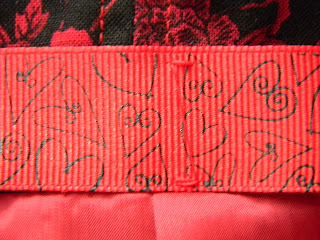or, How to Avoid All That Hand Sewing and Eyeballing
The Craftsy course taught by Gretchen Hirsch features many many hand sewn seams and a lot of eyeballing things. I don't have the time nor the patience for either. I like to have things precise and streamlined, so I documented here the process I used to make the dress.
Gretchen demonstrates in the video how to mark the seam lines with tracing paper and wheel, first on one side and then on the flip side. She cuts out each piece separately, eyeballing about a one inch seam allowance all around. She then thread traces the seam line (either by machine for the muslin or by hand for the final garment). This is to ensure accuracy, but then she advises to sew the seam slightly over to the side of the basting (in the seam allowance) so that it will be easier to remove the basting threads. This to me seems to defeat the whole purpose of accuracy. It seems a better idea would be to baste slightly inside the seam allowance and sew on the actual seam line.
Once the seams are sewn, she advises to trim down the seam allowances to 5/8". I can understand using 1" seam allowances on a muslin for fitting purposes, but on the actual garment, why bother with the huge seam allowance only to trim it down afterward? She recommends leaving the vertical seams at 1" in case you want to let it out down the line. Honestly, the vertical seams have boning and boning casing sewn to them. Who's going to go the trouble of letting out those seams? I would just as soon start a new dress with fresh fabric.
What I did was make a stencil out of the smaller pattern pieces. I carefully drew in 1/2" seam allowances (my preferred width) all around the edges and cut out the actual pattern piece from the center. This enabled me to mark the actual seam line (with my trusty Dritz sewing pencil) as well as have precise seam allowances for matching.
Gretchen hand sews twill tape to the top of the bra cups, easing in some of the fullness along the way. I crowded the top edge, which perfectly shortened it by 1/4" and then applied fusible twill tape over it to stabilize the edge.
Gretchen trims down her batting freehand (her edges are kind of jagged) to make it fit inside the fabric cups. Because I'm a perfectionist, I scaled down the pattern pieces to 98% and cut out a smaller size cup. This made it fit perfectly, just inside the actual seam lines.
Gretchen shows how to fasten all the bust seam allowances by hand to the bra cups. I only tacked it down at the seam junctures; that batting's not going anywhere.
I even used the machine zig zag to attach the waist stay to the lining.
I used 1/2" seam allowances all around, except for the top edges of the dress, where I used 3/4". This creates a "facing" to ensure that the lining fabric doesn't show on the public side.
Gretchen sews the vent down on the right side of the skirt, eyeballing it in kind of in a flying-blind mode. I did this from the inside, where I had the seam allowances as a guide for both the angle and length.
Here it is on the right side.
I mitered the corners on the vent, which reduces a lot of bulk and looks so much better.










thoroughly engaging review, thank you.
ReplyDeleteWow, you really broke it down! Great post.
ReplyDeleteThanks! I'm making this dress now, the gathered part of the skirt is a real pain as I can't get the gather small enough. Agree with you Onthe huge seam allowances on the fashion fabric. That stuff's expensive !